The Art of Weaving Fine Turkish Carpets
I love textile arts and was delighted to stumble upon an artisan weaving a Turkish carpet in Istanbul the other day. I don’t know much about Oriental carpets — just enough to realize you could study the subject for a lifetime and not know everything. But I do admire crafts artistry and I stood in awe watching this skilled craftswoman at her loom. The best carpets are made with hand-spun yarn, naturally-dyed wool or silk, and traditional designs, which was the kind I got to see being made.
Weaving and finishing
As the weaver explained to me, to understand how Turkish carpets are made, you need to understand three terms: “warp” “weft” and “pile.” Warps are the wool, silk or cotton threads tightly stretched parallel to each other that run vertically on the loom, and they form the carpet’s foundation. The loom is the frame on which the warp is strung. Turkish carpets are made by tying knots along the warp.
The weft are threads which pass under and over the warps from one side to the other. To create the pile and the elaborate designs in the carpet, dyed yarn is pulled around consecutive sets of adjacent warps. The pile nodes are then knotted on the warp and one or more horizontal wefts are woven in after each row of knots to further stabilize the carpet. The knotted threads are then pushed firmly down with a comb and cut. Before the knots are pushed down with the comb, the weaver pulls the weft horizontally across the warp. As successive rows are tied to the foundation, these knots become the pile of the carpet.
You’ll see all this in the video on this page. You’ll also see the weaver glancing up to check the chart of her design, pulling the colored yarns down and tying them along the warp, and sliding the horizontal weft thread before she tamps down the weft and knots with the comb. The weaver’s hands moved so swiftly and gracefully her motions reminded me of someone playing a harp.
Dyes and dyeing
The quality of yarn used in a carpet is immensely important to the carpet’s feel, value, and longevity. Is it silk, wool or another material? Is it dyed with natural or synthetic dyes?
The dyeing process starts with preparing the yarn to make it take the dyes. This is accomplished by immersing the yarn in a mordant, a substance used to fix the color, then into the dyeing solution, and finally leaving the yarn to dry exposed to air and sunlight. Some colors, especially dark brown, require iron mordants which can damage or fade the fabric. This often results in faster wear of any pile dyed dark brown, which creates a relief effect in antique Turkish carpets.
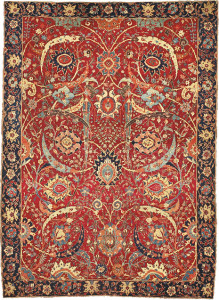
Persian Vase carpets such as this piece are extraordinarily desirable, This “sickle-leaf, vine scroll and palmette ‘vase’-technique carpet,” is probably of Kerman origin and sold for $34 Million US Dollars at auction in 2013
Synthetic dyes were introduced about 160 years ago. They were cheap and easy to use, so they quickly replaced natural dyes. With modern synthetic dyes, nearly every color and shade is possible and in a new carpet, it is very difficult to identify whether natural or artificial dyes were used.
The carpet you see in this video was made of natural vegetable dyes, not synthetics. I learned that using natural dyes again is a fairly recent return to the traditional way of making carpet, and makes a more expensive carpet because it takes a lot more effort to make the colored yarns using natural dyes.
Natural, traditional dyes in Turkish carpets come from plants, insects and minerals. Blue comes from Indigofera tinctoria, black from acorns, apples and tanner’s sumach; yellow from plants, mainly onions, chamomile and euphorbia, and red comes from madder roots. Green is made by blending or double-dying indigo and yellow dyes, and orange is made by double dying the red and yellow dyes.
Knots
Watching the weaver work, you will be amazed at how expertly and quickly she ties the intricate knots. I asked what kind of knots she was making, and this is what I learned. Turkish carpets use the symmetrical knot, or “giordes” knot.” Persian carpets most commonly use the “senneh” or asymmetrical knot.

the symmetrical Turkish knot
The symmetrical Turkish knot is made on two warps. With this form of knotting, each end of the pile thread is twisted around two warp threads at regular intervals, so that both ends of the knot come up between two strands on one side of the carpet. The thread is then pulled downwards and cut with a knife. You can see the weaver doing this in the video.

the asymmetrical Persian knot
After a row of knots has been made, one or two, sometimes more, rows of wefts are woven in, and the carpet is compacted by being beaten with a heavy comb. The pile of the carpet is then shorn with special scissors or knives to obtain an equal surface. You can see the weaver doing this in the video also.
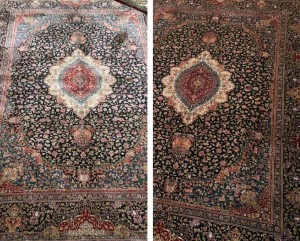
This is the same carpet seen from two angles, looking very different; that’s because of the way the pile falls.
The upright pile of Turkish rugs usually falls in one direction, as knots are always pulled down before the string of pile yarn is cut off and work resumes on the next knot, piling row upon row of knots on top of each other. This makes the color of the carpet look different depending on which direction you’re viewing it from.
What are Turkish Carpets Made of?
Only natural fibers are used in handmade carpets. The most common materials used for the pile are wool, silk and cotton. Sometimes, goat and camel hair are also used by nomadic and village weavers. Traditionally, spinning is done by hand. Several strands of yarn are spun together so that the resulting yarn is strong enough to be used for weaving.
How Expensive Can Carpets Be?
The most expensive new carpet ever sold was a Turkish carpet, made by LoomArt, known as “Universe.” It was sold at the 2010 International Furniture and Design Exhibition in Doha for $3.2 million US Dollars. The carpet portrays 200 animals, the moon, the sun and symbols of the 12 months, vividly depicted in 50 different colors by three master weavers over four and a half years tying 17,800,000 double knots. The carpet is also made with one kg or 24-karat pure gold.
An antique Persian Clark Sickle-Leaf carpet from the early 17th century sold in New York City for $33.7 million at Sotheby’s auction house. The Tabriz Medallion Carpet, from northwest Persia, was made in the 16th Century and features traditional Persian designs, accented with feathers and maple-leaf-shaped fans.
Does anyone have pictures of Turkish carpets they own, or bought in Turkey? I’d love to see them and share the photos if you’d allow. I’d also like to hear about where you bought it, if you feel you got the quality you expected and if the price you paid was good, and about the negotiating process you went through. Please share!

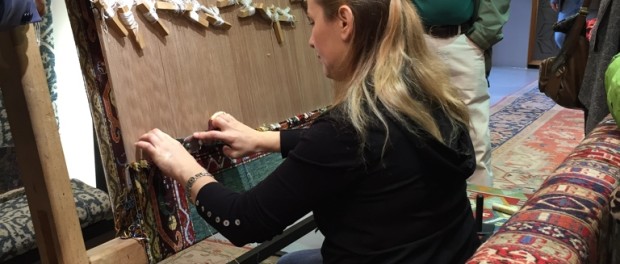
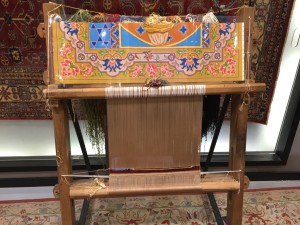
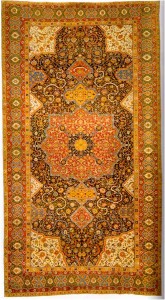
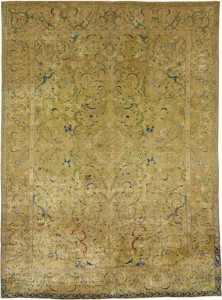
Absolutely fascinating! I’ll take the blue one!